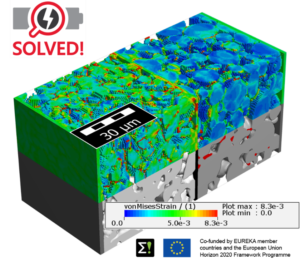Summary:
During cycling, volumetric changes of the active material induce stresses on the micro- and macro-scale, leading to cracks and delamination, and deformation of the inactive layers and the casing. The altered microstructure is said to “age” and suffers from capacity loss and damaging effects like lithium-plating. The quantitative simulation of this battery aging on a microstructural level is now jointly pursued by Math2Market and the MaDE group of Prof. Vanessa Wood (ETH Zürich) in the framework of the EU-project “SOLVED!”.
Our approach is to analyze state-of-the-art NMC cathode and graphite anode microstructures via 3D tomography and electrochemical characterization. The experimental data is used to validate the degradation simulations in which local volumetric changes and damage due to lithium intercalation on the microscale are linked to the local Li-ion concentration of the active material and its mechanical deformation. In a dynamic process, the altered microstructure is considered for each charging and discharging step. In this way, the influence of structural changes on the electronic and ionic transport processes and on the macroscopic performance of the cell is digitally predicted and monitored.
For the digital optimization and design of battery materials, aiming at superior lifetime and performance, statistical Digital Twins are generated to match the battery electrodes, and later analyzed regarding their aging behavior. The generation of the Statistical Digital Twins is based on the geometric analysis of models from the 3D tomography data and the computation of the transport properties of the electrode microstructure. These models exhibit statistically the same properties as the original electrodes. By digitally varying the geometric properties of the generated electrode microstructures, like grain size and orientation, volume ratios and material gradients, key parameters such as ion diffusivity, geometric tortuosity and active surface area are optimized regarding their influence on the aging behavior of the electrode.
New prototype materials with superior lifetime and performance can be then manufactured and experimentally characterized and new design principles can be reached. This unique workflow represents a timesaving and streamlined digital R&D material design for new energy materials in e-mobility and energy storage.
We are happy to forward your request / feedback.

